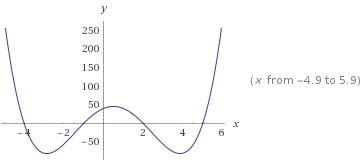Question #490b3
1 Answer
Jan 6, 2018
Please see below.
Explanation:
.
A polynomial of degree
It has four roots, i.e. if you solve for
So, you can pick
Then, you can write your function as follows:
After multiplying them through and removing parentheses, you get:
Here is its graph:

As you can see. the graph crosses the

